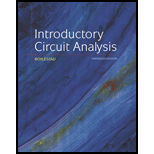
Concept explainers
For each configuration in Fig. 5.88, find the individual (not combinations of) elements (voltage sources and/or resistors) that are in series.
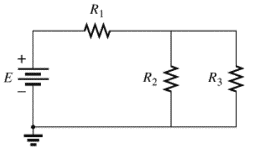
(a)
The individual elements that are connected in series for the given configuration.
Answer to Problem 1P
The individual elements that are connected in series for the given configuration are
Explanation of Solution
Given:
The circuit is given below.

Calculation:
The given circuit is analyzed by the rules of series-parallel combination.
As per the series combination rule,
Conclusion:
(b)
The individual elements that are connected in series for the given configuration.
Answer to Problem 1P
The individual elements that are connected in series for the given configuration are
Explanation of Solution
Given:
The circuit is given below,
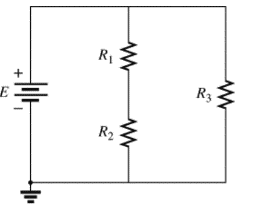
Calculation:
The given circuit is analyzed by the rules of series-parallel combination.
As per the series combination rule,
Conclusion:
(c)
The individual elements that are connected in series for the given configuration.
Answer to Problem 1P
The individual elements that are connected in series for the given configuration are
Explanation of Solution
Given:
The circuit is given below,
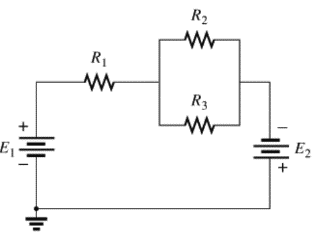
Calculation:
The given circuit is analyzed by the rules of series-parallel combination.
As per the series combination rule,
Conclusion:
(d)
The individual elements that are connected in series for the given configuration.
Answer to Problem 1P
The individual elements that are connected in series for the given configuration are
Explanation of Solution
Given:
The circuit is given below,
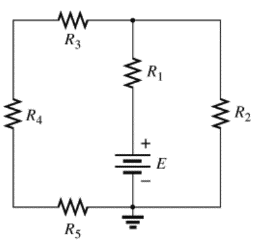
Calculation:
The given circuit is analyzed by the rules of series-parallel combination.As per the series combination rule of resistances,
Conclusion:
Therefore,
Want to see more full solutions like this?
Chapter 5 Solutions
Introductory Circuit Analysis (13th Edition)
Additional Engineering Textbook Solutions
Fundamentals of Applied Electromagnetics (7th Edition)
Electrical Engineering: Principles & Applications (7th Edition)
Modern Database Management
Foundation Design: Principles and Practices (3rd Edition)
Web Development and Design Foundations with HTML5 (8th Edition)
C++ How to Program (10th Edition)
- what can we conclude in this pure resistance experimentarrow_forwardi need the answer quicklyarrow_forwardJustify the reason, why the true value of a circuit is changed into reduced measured value because of the insertion of a meter for measuring the true value. Mention how it will affect measurement in voltmeter with necessary drawings. Also, Suggest one method to reduce the effect.arrow_forward
- In figure 5.1 of Experiment # 5, what is the computed value of RTH? Show the complete solution. 752 1502 A 5V 2202 4702 B RTH Blank 1 0 (type your answer with 2 decimal places)arrow_forwardBreadboard Projects Propose a SIMPLE PROJECT with the use of Basic Electronic Components and Define why you’ve chosen/decided to propose that project? What is itsimportance? Requirements :Title of the Project:Its Importance:List of Components:Breadboard Layout:arrow_forward5. How do the 2 different voltmeter readings compare to each other and to the voltage predicted by circuit theory? MacBook Proarrow_forward
- Show and COMPLETE solutions. Draw all CIRCUIT DIAGRAMS or the equivalent circuit (dummy circuit) as the case may be. A battery is to consist of 20 identical cells. The emf of each cell is 1.5 V and the internal resistance is 0.20 ohm. This battery will be used to supply power to a 10-ohm lamp. Determine thecurrent on the lamp if: The 20 cells are arranged 5 cells in series in 4 parallel rows.arrow_forwardDraw a schematic (circuit) diagram of four resistors connected to a source (EMF) , where should have the same current with the total current in the circuit, while share this total amount of current at the same time. have the same values with the following color bands: red, black, red, gold; while also have the same values with the following color bands: yellow, violet, brown, gold. Applying the rules in series and parallel circuits as well as Ohm's law, discuss your complete solution conceptually and mathematically. In your own words, discuss comprehensively your strategic analysis on how to solve the problem. Show logical and systematic computations to solve for the unknowns. Present your evaluated data (final answers) in a tabular matrix. Express your final answers in two decimal places. Use the template below.arrow_forwardThree friends decided to connect their individual car batteries in parallel using ideal cables (negligible resistance) to power up the car of their fourth stranded friend as shown in this circuit. Unknown to them, their batteries are not fully charged and have different series resistance values and voltages as indicated. The starter motor of the fourth friend's car has an effective resistance of 0.185 ohms. How much current will be supplied by their parallel combination to the starter motor of the car and what is the Thevenin voltage of the parallel combination as seen by the starter motor element M?arrow_forward
- Another resistor is made out of aluminum (o = 3.5.107) with the same length and resistance as the one made out of gold. Is its cross section greater or smaller than that of the one made out of gold? Explain.arrow_forward1a. Calculate the equivalent resistance of R4 and R5 1b. Adding the values of resistor R1 and R2 to R equivalent. Calculate the circuit resistance seen by the power source. 2a. Measure the total resistance across terminals A and D, using ohmmeter function of the electronic VOM. Make sure that switch S1 is in the open position. Measured Total Resistance in Multisim= 4.15kohms 2b. Does the measured total resistance agree exactly with your calculated resistance? Explainarrow_forwardexample (H.w): A Current has an internal resistance of 782 ed to measure the Current through Rc in the below is used creuit. Find the percentuge error of the reading due to Ammeter hocaeding. Razike Rbzikuz AAmmeterarrow_forward
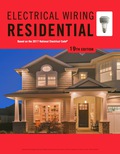 EBK ELECTRICAL WIRING RESIDENTIALElectrical EngineeringISBN:9781337516549Author:SimmonsPublisher:CENGAGE LEARNING - CONSIGNMENT
EBK ELECTRICAL WIRING RESIDENTIALElectrical EngineeringISBN:9781337516549Author:SimmonsPublisher:CENGAGE LEARNING - CONSIGNMENT
